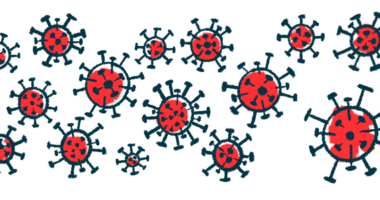CFTR Protein Defects May Work to Protect Against Severe COVID-19

Problems with the CFTR protein — which causes cystic fibrosis (CF) — limit the replication and spread of SARS-CoV-2, the virus that causes COVID-19, in cells of the lung’s airways to protect patients, a study suggests.
Cells lacking the CFTR gene responsible for that protein also had poorer expression, or activity, of a protein called ACE-2 that is used by the virus to enter cells.
“People with cystic fibrosis (pwCF) should be considered at high risk of developing severe symptoms of COVID-19” due to disease-related frequent lung infections, the researchers in Italy wrote. “However, recent studies have indicated … a lower clinical impact of SARS-CoV-2 infection, with mild courses of viral disease and no … intensive care unit admission.”
This “intriguing observation” led to the study “CFTR Modulation Reduces SARS-CoV-2 Infection in Human Bronchial Epithelial Cells,” published in the journal Cells.
CF is caused by mutations in the CFTR gene that impair or prevent the production of a gate-like protein, also called CFTR, that regulates the flow of water and salts in and out of cells. These mutations cause the buildup of thick mucus in various organs, including the lungs — an ideal environment for bacteria.
The resulting inflammation and chronic infections “are the main culprits of CF-related morbidity and mortality,” the scientists noted.
A team at the University of Verona investigated how changes to the CFTR protein in CF patients may impact the ability of the SARS-CoV-2 virus to enter and replicate inside airway cells.
To understand how the CFTR protein might affect the SARS-CoV-2 virus, these scientists ran tests using human bronchial epithelial cells, which line the tubes that conduct air into the lungs. Some of these epithelial cells had normal or wild-type (WT) CFTR protein, while others were affected by the F508del mutation, the most common CF-causing change.
Cells were infected with SARS-CoV-2 and the viral load analyzed up to 72 hours after infection.
A lower viral load was seen in F508del-CTFR cells than wild type cells and showed “a time-dependent trend,” the researchers reported. In particular, F508del-CTFR cells were slower to be infected by COVID than WT cells, with a peak of infection at 48 hours rather than 24 hours.
These findings were later confirmed using MucilAir, a cell model of the human lung epithelium, and maintained when the team repeated the experiments using another SARS-CoV-2 virus strain.
Since the virus enters cells mainly by interacting with the cell surface angiotensin-converting enzyme 2 (ACE-2) protein, the scientists looked for differences in ACE-2 levels between WT and cells with mutated protein. They found that WT cells had increased expression of ACE-2 messenger RNA (mRNA) — the molecule generated from DNA that serves as a template for protein production — compared to F508del-CTFR cells, particularly at 72 hours post-infection.
Distribution of the ACE-2 protein also differed between these cells. This protein was located at the membrane in WT cells, and “variously distributed” within the body of F508del-CTFR cells.
Investigators then tested the virus’ ability to infect cells engineered to completely lack the CFTR gene and, subsequently, the CFTR protein. In agreement with previous F508del results, the protein’s absence had a greater effect on viral replication compared with WT cells, and also associated with a marked reduction in ACE-2 protein levels.
Since the CFTR protein regulates the flow of chloride in and out of cells, the researchers wondered if the protein’s function affected viral load more than CFTR levels.
To test this, they incubated WT cells expressing a working CFTR with a selective inhibitor of the protein’s channel function that had been tested in a Phase 2 trial as a treatment of diarrhea.
Compared with WT cells not given this blocker, those given it showed a significant decrease in viral load 72 hours after infection.
This drop in viral load among inhibitor-treated cells also remained significant when compared with the load seen in cells whose protein was affected by F508del mutations, the researchers wrote.
As a final experiment, the team partially recovered the CFTR function by treating WT and F508del-CTFR cells grown in the MucilAir with a combination of elexacaftor and tezacaftor, both of which are part of CFTR modulator combination therapies by Vertex Pharmaceuticals.
Recovery of CFTR function in F508del-CTFR cells led to greater viral replication than in untreated cells, with a “particularly evident” rise in viral particles at 48 hours post-infection, the researchers wrote.
“Our study provides evidence that CFTR expression/function is involved in the regulation of SARS-CoV-2 replication,” they concluded, “thus providing novel insights into the role of CFTR in SARS-CoV-2 infection and the development of therapeutic strategies for COVID-19.”
Mechanisms underlying its findings, however, need further investigation, they added.








